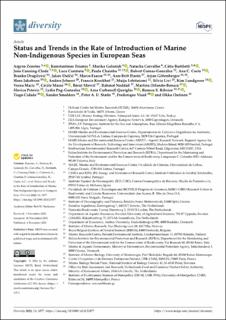Status and Trends in the Rate of Introduction of Marine Non-Indigenous Species in European Seas
| dc.contributor.author | Zenetos, Argyro | |
| dc.contributor.author | Tsiamis, Konstantinos | |
| dc.contributor.author | Galanidi, Marika | |
| dc.contributor.author | Carvalho, Natacha | |
| dc.contributor.author | Bartilotti, Cátia | |
| dc.contributor.author | Canning-Clode, João | |
| dc.contributor.author | Castriota, Luca | |
| dc.contributor.author | Chainho, Paula | |
| dc.contributor.author | Comas-González, Robert | |
| dc.contributor.author | Costa, Ana C. | |
| dc.contributor.author | Dragičević, Branko | |
| dc.contributor.author | Dulčić, Jakov | |
| dc.contributor.author | Faasse, Marco | |
| dc.contributor.author | Florin, Ann-Britt | |
| dc.contributor.author | Gittenberger, Arjan | |
| dc.contributor.author | Jakobsen, Hans | |
| dc.contributor.author | Jelmert, Anders | |
| dc.contributor.author | Kerckhof, Francis | |
| dc.contributor.author | Lehtiniemi, Maiju | |
| dc.contributor.author | Livi, Silvia | |
| dc.contributor.author | Lundgreen, Kim | |
| dc.contributor.author | Macic, Vesna | |
| dc.contributor.author | Massé, Cécile | |
| dc.contributor.author | Mavrič, Borut | |
| dc.contributor.author | Naddafi, Rahmat | |
| dc.contributor.author | Orlando-Bonaca, Martina | |
| dc.contributor.author | Petovic, Slavica | |
| dc.contributor.author | Png-Gonzalez, Lydia | |
| dc.contributor.author | Carbonell Quetglas, Aina | |
| dc.contributor.author | Ribeiro, Romeu S. | |
| dc.contributor.author | Cidade, Tiago | |
| dc.contributor.author | Smolders, Sander | |
| dc.contributor.author | Stæhr, Peter A. U. | |
| dc.contributor.author | Viard, Frederique | |
| dc.contributor.author | Outinen, Okko | |
| dc.date.accessioned | 2023-01-17T12:33:42Z | |
| dc.date.available | 2023-01-17T12:33:42Z | |
| dc.date.created | 2023-01-10T10:42:31Z | |
| dc.date.issued | 2022 | |
| dc.identifier.citation | Diversity. 2022, 14 (12), . | en_US |
| dc.identifier.issn | 1424-2818 | |
| dc.identifier.uri | https://hdl.handle.net/11250/3044024 | |
| dc.description.abstract | Invasive alien species are a major worldwide driver of biodiversity change. The current study lists verified records of non-indigenous species (NIS) in European marine waters until 2020, with the purpose of establishing a baseline, assessing trends, and discussing appropriate threshold values for good environmental status (GES) according to the relevant European legislation. All NIS records were verified by national experts and trends are presented in six-year assessment periods from 1970 to 2020 according to the European Union Marine Strategy Framework Directive. Altogether, 874 NIS have been introduced to European marine waters until 2020 with the Mediterranean Sea and North-East Atlantic Ocean hosting most of the introductions. Overall, the number of new introductions has steadily increased since 2000. The annual rate of new introductions reached 21 new NIS in European seas within the last six-year assessment period (2012–2017). This increase is likely due to increased human activities and research efforts that have intensified during the early 21st century within European Seas. As Europe seas are not environmentally, nor geographically homogenous, the setting of threshold values for assessing GES requires regional expertise. Further, once management measures are operational, pathway-specific threshold values would enable assessing the effectiveness of such measures. | en_US |
| dc.language.iso | eng | en_US |
| dc.title | Status and Trends in the Rate of Introduction of Marine Non-Indigenous Species in European Seas | en_US |
| dc.title.alternative | Status and Trends in the Rate of Introduction of Marine Non-Indigenous Species in European Seas | en_US |
| dc.type | Peer reviewed | en_US |
| dc.type | Journal article | en_US |
| dc.description.version | publishedVersion | en_US |
| dc.source.pagenumber | 50 | en_US |
| dc.source.volume | 14 | en_US |
| dc.source.journal | Diversity | en_US |
| dc.source.issue | 12 | en_US |
| dc.identifier.doi | 10.3390/d14121077 | |
| dc.identifier.cristin | 2103847 | |
| cristin.ispublished | true | |
| cristin.fulltext | original | |
| cristin.qualitycode | 1 |
Tilhørende fil(er)
Denne innførselen finnes i følgende samling(er)
-
Articles [3001]
-
Publikasjoner fra CRIStin [3025]
